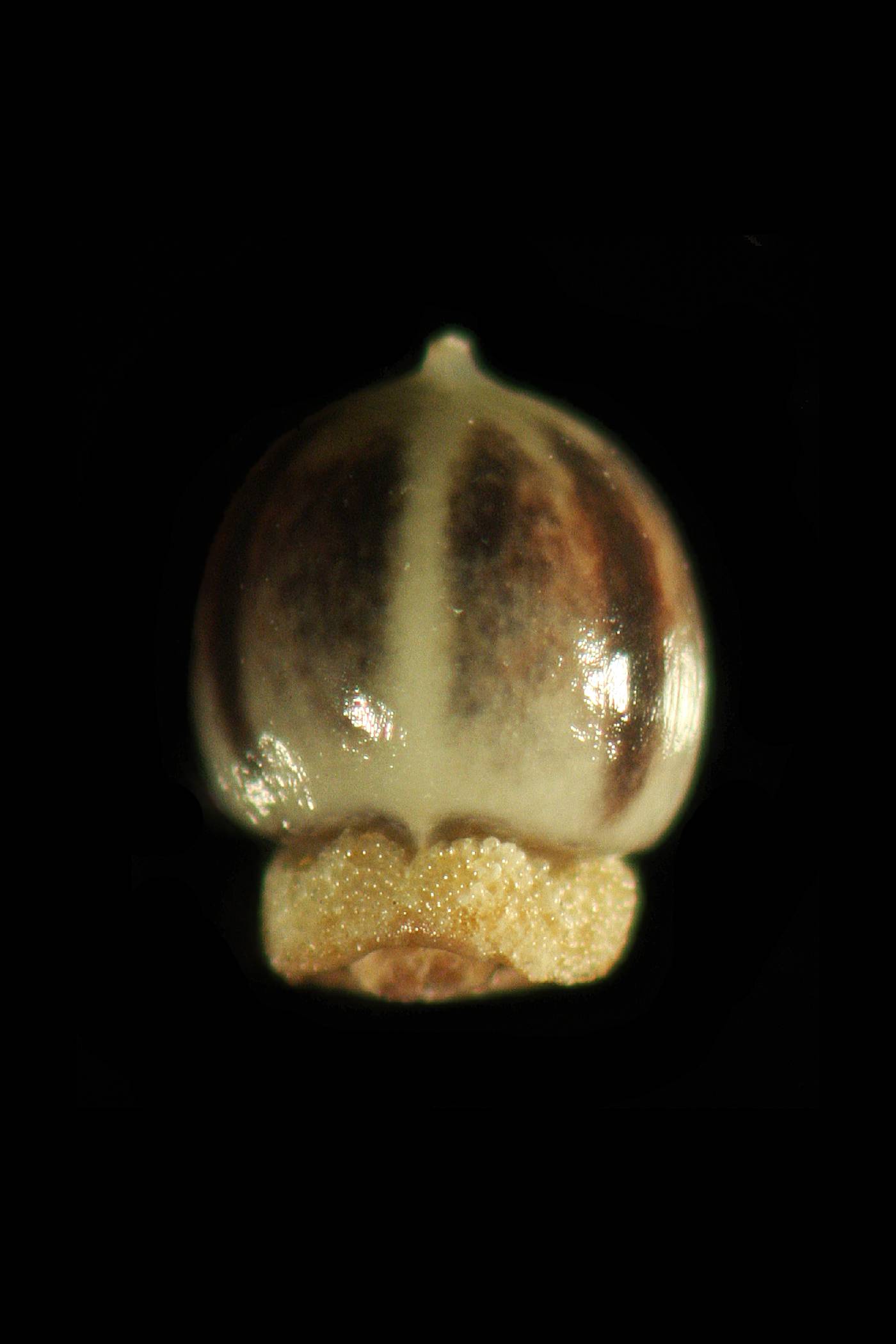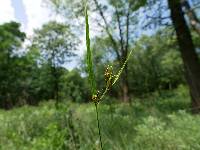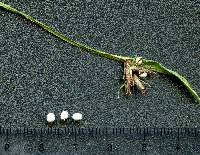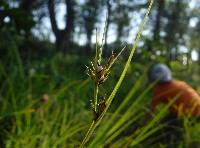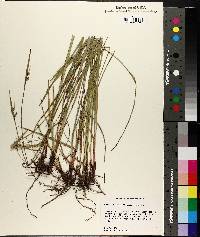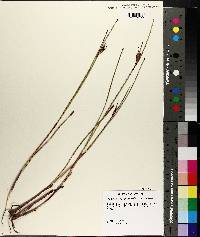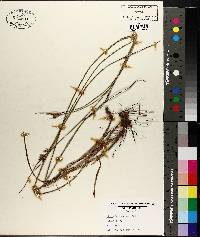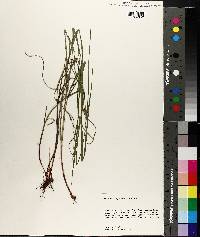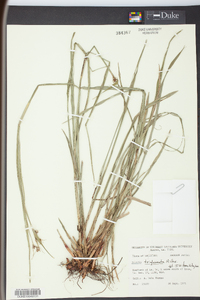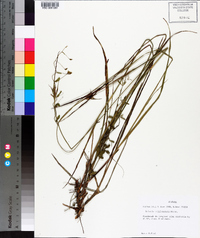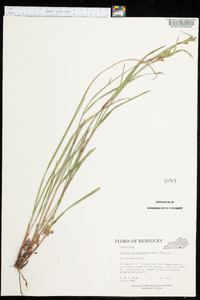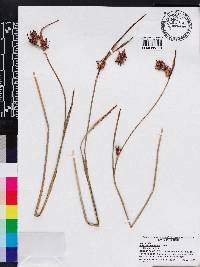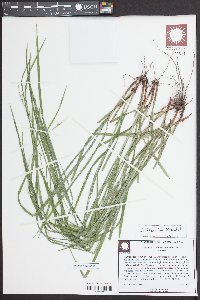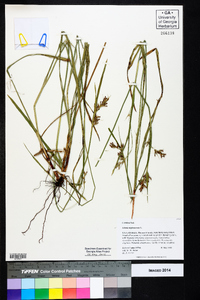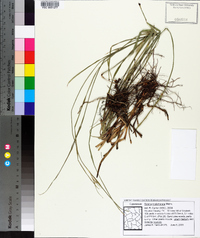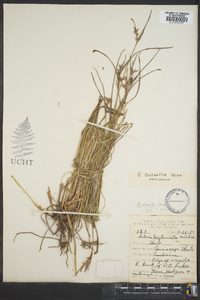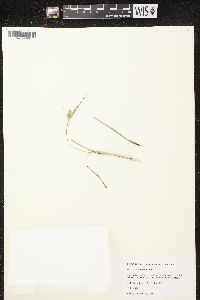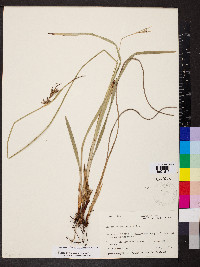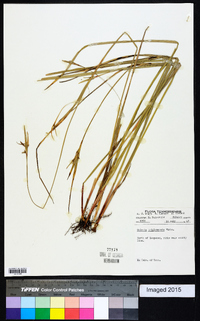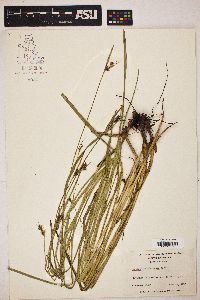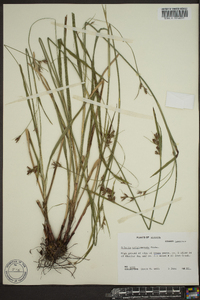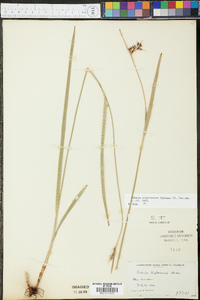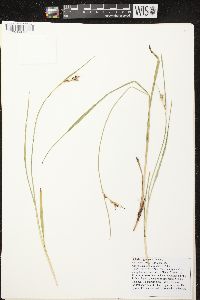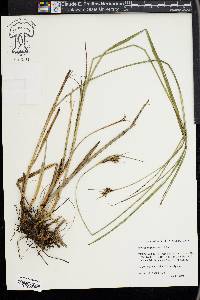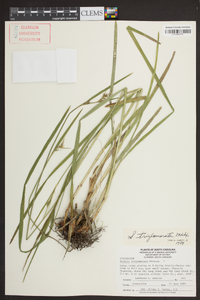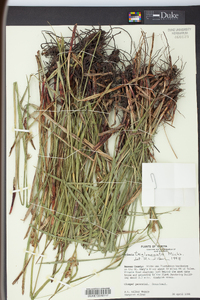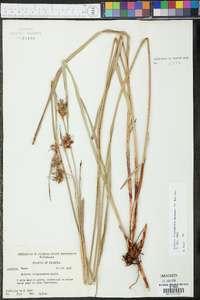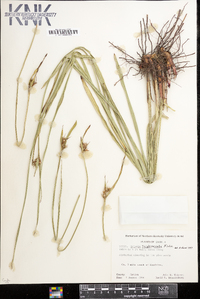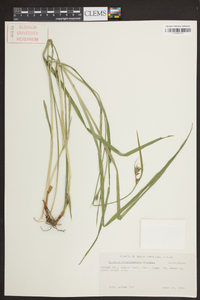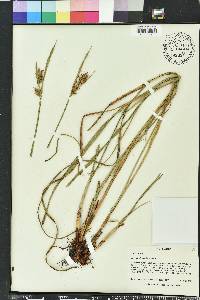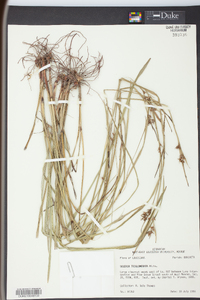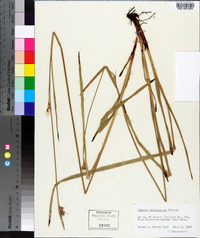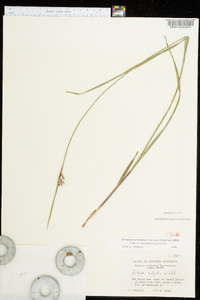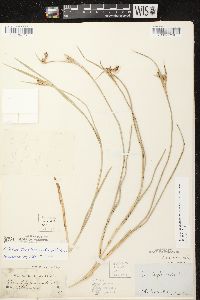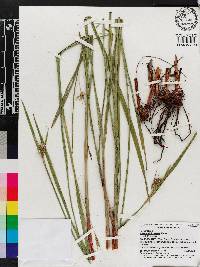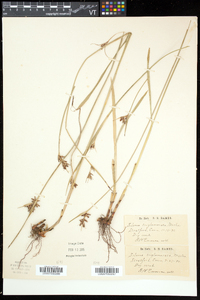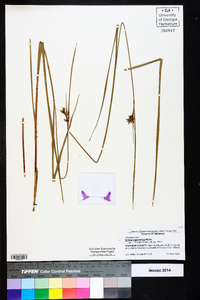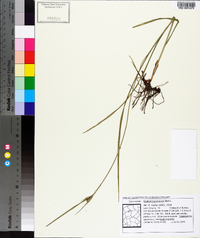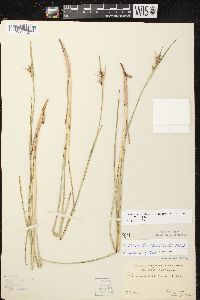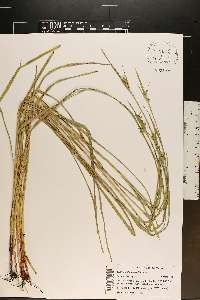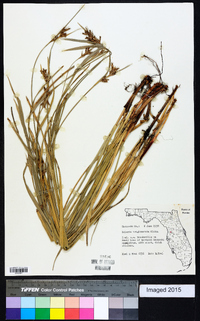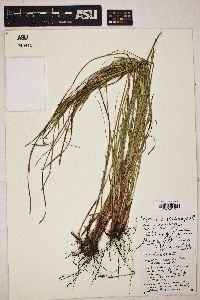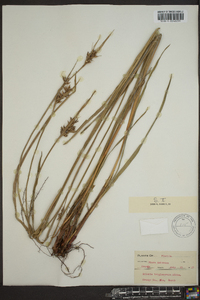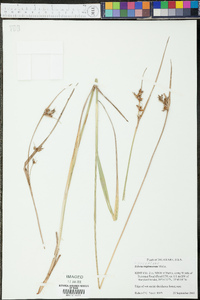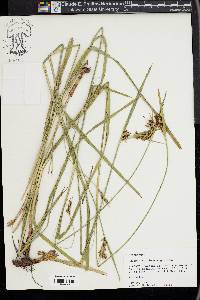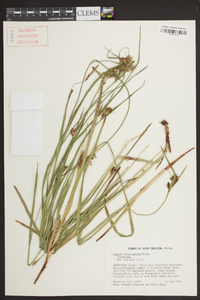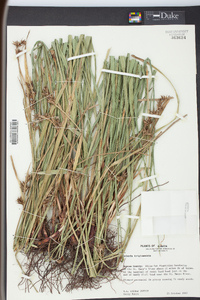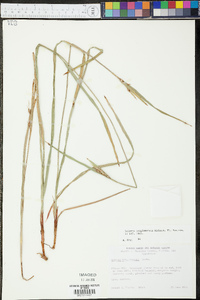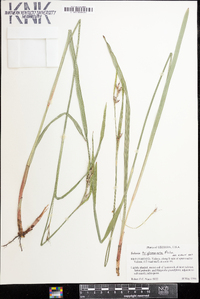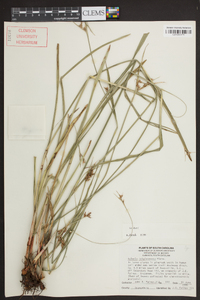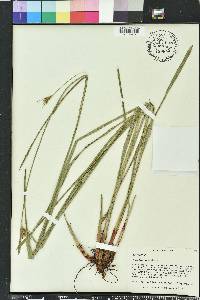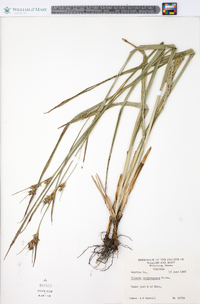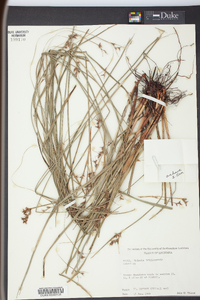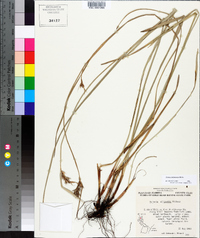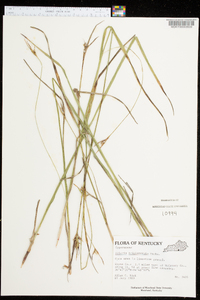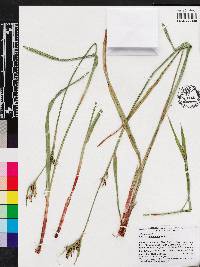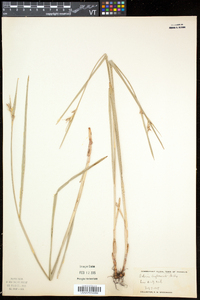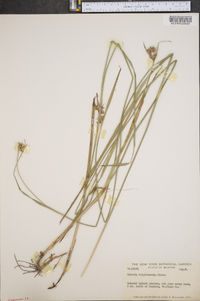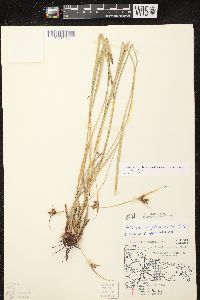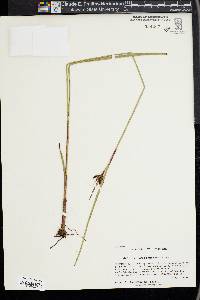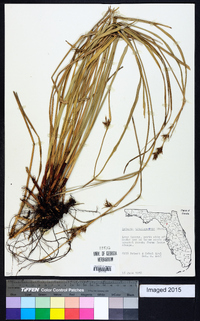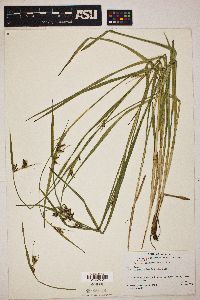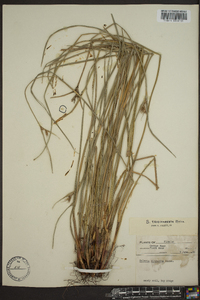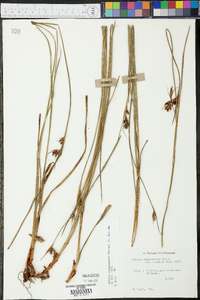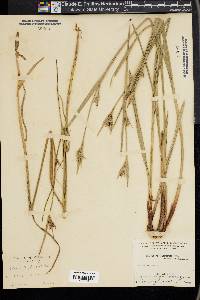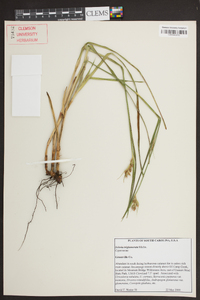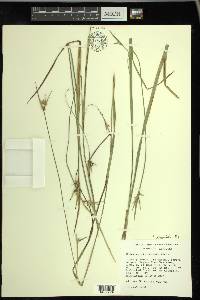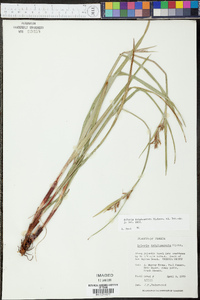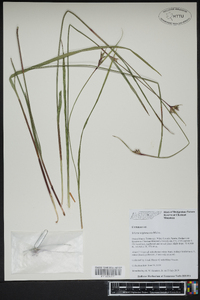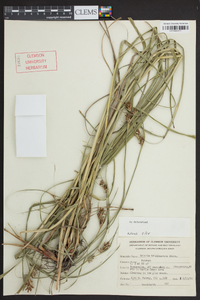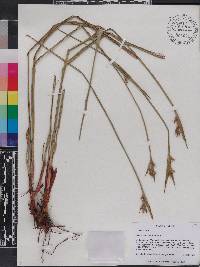Scleria triglomerata
|
|
|
|
Family: Cyperaceae
Whip Nut-Rush, more...whip nutrush
|
Plants perennial; rhizomes clustered, stout, nodulose, hard. Culms usually in tufts, stout, 40-100 cm, glabrous, somewhat scabrous distally. Leaves: sheaths purplish, not winged, pilose or glabrous; contra-ligules ovate, rarely trigonous; blades linear, ribbed, shorter than culms, 3-9 mm wide, rigid, margins and midrib scabrous, sometimes slightly pubescent. Inflorescences terminal and axillary, fasciculate; fascicles 3, 15-40 × 5-15 mm, each with (1-) 3-10(-12) spikelets (smaller numbers in shade forms); lateral peduncles erect, often becoming filiform and pendulous in deep shade forms; bracts subtending inflorescence leaflike, lanceolate, 3-11 cm, long-acuminate-attenuate, ciliate or glabrous. Spikelets bisexual and staminate (sometimes reduced to few flowers in bisexual spikelets), brown, 3-9 mm; staminate scales ovate-mucronate to lanceolate-acuminate, pistillate scales ovate, midrib excurrent, often awnlike. Achenes sometimes grayish brown, sometimes with dark longitudinal bands, ovoid to subglobose, 2-3 mm, smooth, shining, apex obtuse; hypogynium low, obscurely 3-angled, covered with whitish or brownish, siliceous, papillose-spiculose crust. Fruiting summer. Dark woods to open, moist pinelands, meadows, swales, prairies, and savannas; 0-900 m; Ont.; Ala., Ark., Conn., Del., D.C., Fla., Ga., Ill., Ind., Iowa, Kans., Ky., La., Md., Mass., Mich., Minn., Miss., Mo., Nebr., N.J., N.Y., N.C., Ohio, Okla., Pa., R.I., S.C., Tenn., Tex., Va., W.Va., Wis. Scleria triglomerata is by far the most common and widespread species of Scleria in the flora region. It exhibits considerable ecologic amplitude, growing in shady woods to open pinelands. Past authors have sometimes separated the species into several, recognizing S. nitida and S. flaccida. Plants that fit all the characteristics of the segregates seem distinctive; apparent intermediates occur.
Perennial herb with hard, knotty rhizomes, usually tufted 40 cm - 1 m tall Leaves: three-ranked. Sheaths purplish, sometimes hairy. Ligules egg-shaped. Blades rigid, 3 - 9 mm wide, shorter than culm, linear, ribbed, midvein prominent, rough along the margins and midrib, sometimes slightly hairy. Inflorescence: composed of three spikelet bundles, axillary and terminal, 1.5 - 4 cm long, 0.5 - 1.5 cm wide, subtended by leaf-like bracts. Bracts 3 - 15 cm long, lance-shaped with a long, tapering tip. Bundles commonly with three to ten spikelets each, stalked. Lateral stalks upright, sometimes thread-like and drooping (when in deep shade). Flowers: either male or female, borne on the same plant (monoecious), minute, subtended by a floral scale, lacking sepals and petals. Stamens one to three, exserted. Anthers 2.5 - 4 mm long. Pistil one. Style linear, two- to three-cleft. Fruit: a one-seeded achene, white to grayish brownish, occasionally dark-banded longitudinally, 2 - 3.5 mm wide, nearly spherical to egg-shaped with a blunt apex, shiny, subtended by a disk-like structure (hypogynium). Hypogynium low, obscurely three-angled, covered with a whitish or brownish, bumpy crust. Culm: 40 cm - 1 m long, three-sided, solid, sometimes hairy. Spikelets: bisexual and male, brown, 3 - 9 mm long. Male scales egg-shaped with a short point at the apex or lance-shaped with a tapering apex. Female scales egg-shaped with a midrib that extends beyond the apex. Similar species: No information at this time. Flowering: June to September Habitat and ecology: Local in calcareous prairies. It is also found in the sandy areas of marsh borders and in sand prairies. Occurence in the Chicago region: native Etymology: Scleria comes from the Greek word scleria, meaning hardness, referring to the fruit. Triglomerata means "with three clusters." Author: The Morton Arboretum Culms to 1 m, from hard, knotty rhizomes; main blades 4-8 mm wide, often hairy, abruptly attenuate; cymes 1-3, the lower pedunculate; bracts foliaceous, the lowest erect, 5-15 cm; staminate scales lanceolate, acuminate; anthers 2.5-4 mm; pistillate scales ovate, the midrib prolonged into a short awn; achenes white, rarely drab or gray, 2.5-3.5 mm, apiculate, the body as long as or a little longer than thick, blunt or apiculate; hypogynium white, papillose-crustaceous. Moist or dry sandy soil and pine-barrens; Mass. to Wis., s. to Fla., Tex., Puerto Rico, and Mex. (S. flaccida; S. nitida) Gleason, Henry A. & Cronquist, Arthur J. 1991. Manual of vascular plants of northeastern United States and adjacent Canada. lxxv + 910 pp. ©The New York Botanical Garden. All rights reserved. Used by permission. From Flora of Indiana (1940) by Charles C. Deam Very local and only a few plants found at a place. It grows in moist, sandy soil in prairie habitats or in marshes. …… Indiana Coefficient of Conservatism: C = 10 Wetland Indicator Status: FAC |
|
|
|

